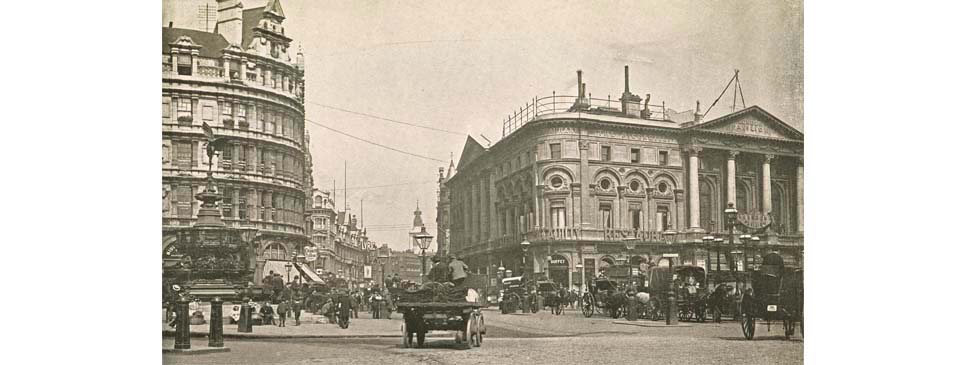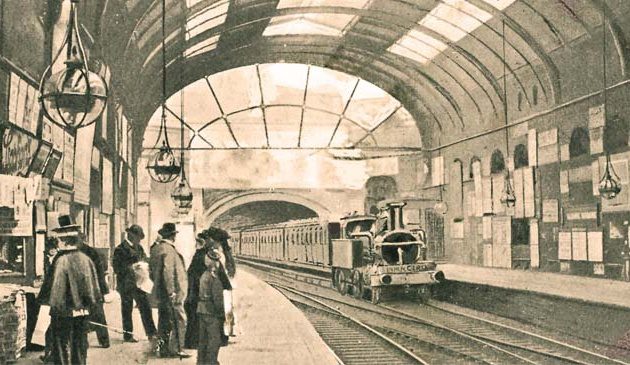In brief – Late-Victorian London

Piccadilly Circus at the end of the 19th century. We see along Shaftesbury Avenue, which was laid out in 1886 from here to Cambridge Circus and on to New Oxford Street. At the same time, the former London Pavilion music hall, seen on the right, was rebuilt and enlarged as a grand variety theatre. On the left is the Shaftesbury Memorial Fountain, erected in 1892-3 and topped by Anteros, but normally mistakenly known as ‘Eros’. Both the fountain and street are named after the philanthropist, the 7th Earl of Shaftesbury.
The middle of the century was the zenith of evangelical Protestantism. Thousands attended sermons given by fire-and-brimstone preachers such as Charles Haddon Spurgeon. The National Vigilance Association fought sexual vice wherever they found it and a number of organisations of all denominations preached the virtues of temperance. The Methodist William Booth founded the Christian Mission in Whitechapel and the military-style Salvation Army. At the same time the Reverend Samuel Barnett and his wife Henrietta promoted a very different kind of religious and social philosophy. Their Universities’ Settlement Movement brought together at Toynbee Hall privileged men and the East End’s poor. Yet by the end of the century London was a more secular city, with many of the working classes preferring to use their one day of rest for enjoyment rather than worship. Many who had been motivated by missionary charity work were instead turning to socialism.
War and famine in their homelands in Eastern Europe brought increasing numbers of Ashkenazi Jews to London, becoming a mass exodus from the time of the start of the Russian pogrom in the 1880s. By the end of the century around 140,000 were living in London. They mostly settled in a relatively small area to the east of Aldgate where they could find cheap accommodation and a support network consisting of local synagogues, Yiddish schools and kosher food. As their numbers grew they squeezed into increasingly overcrowded housing, with many working in the garment business around Whitechapel or Soho, or as street-sellers.
With so many people living in overcrowded and squalid conditions in London, epidemics of tuberculosis, smallpox, cholera, typhus and influenza were common throughout the 19th century, killing thousands. By the second half of the century the capital had numerous charitable hospitals, with growing expertise in all fields of medicine and treatment. Recently returned from the battlefields of the Crimea, Florence Nightingale founded a nursing school at St. Thomas’s Hospital, which itself moved to its present site at Lambeth.
During the 19th century there were growing demands from Britain’s working classes for political and social reform. The Reform League organised demonstrations in London demanding change and the Fabian Society aimed to improve society through gradual, rather than revolutionary, transformation. After the prosperity of the 1870s came the economic slump of the mid-1880s, several bitterly cold winters, unemployment and hardship for many of the working classes, and a new intensity in socialist political activity. London’s dockers were amongst the most militant workers, regularly taking strike action. There was a notable strike by the female workers at the Bryant & May match factory in 1888. A mass march to Trafalgar Square in 1887 was violently dispersed, known as ‘Bloody Sunday’. Various trade unions were formed, coming together under the banner of the Trades Union Congress.
Militant Irish republicans known as ‘Fenians’ were active in London during the 19th century. In 1867 they attempted to free two of their members from Clerkenwell Prison by blowing a hole in its wall. The scheme went spectacularly wrong, resulting in the demolition of houses opposite and the deaths of seventeen people. During the 1880s there were a number of further Fenian bombings in London, of which the most dramatic was when one exploded on the underground railway at Paddington. These events led to the formation of the Special Branch at Scotland Yard (initially called the Special Irish Branch), the first specialist sub-division of the Criminal Investigation Department.


